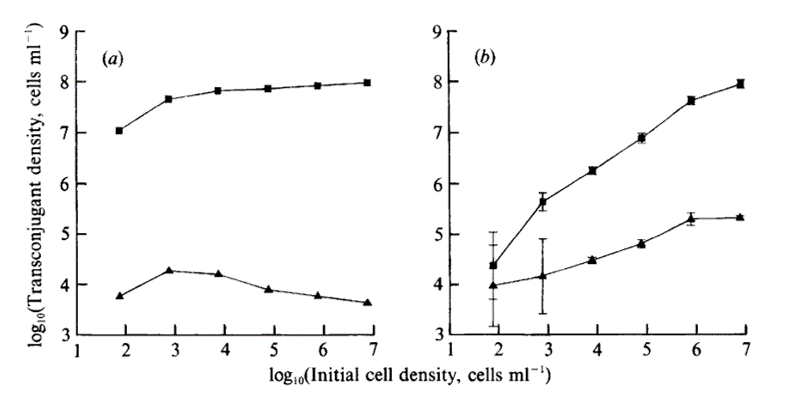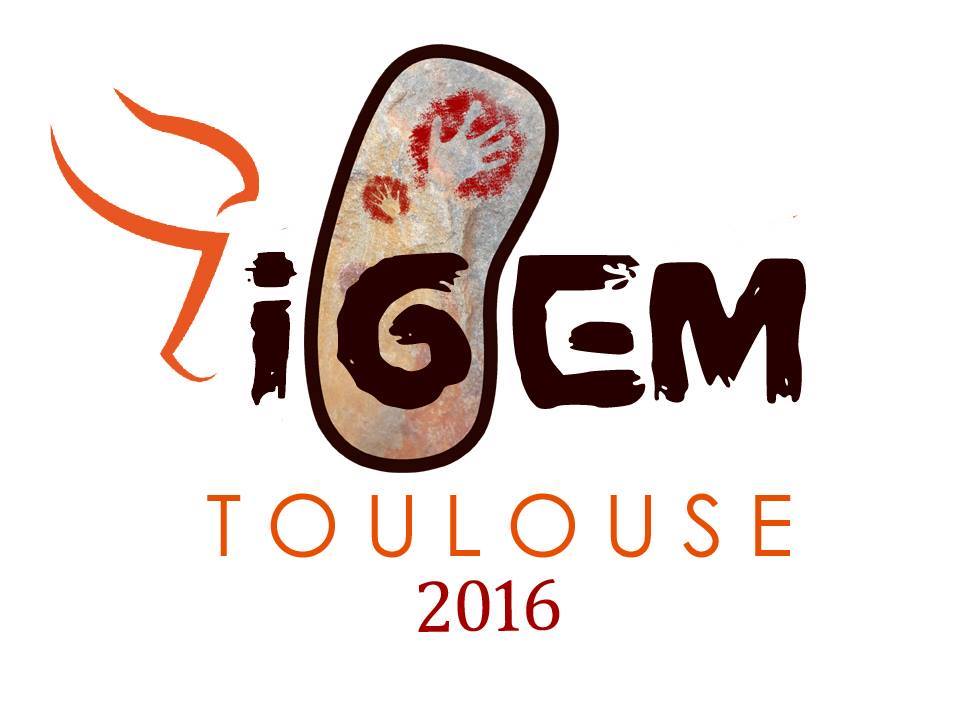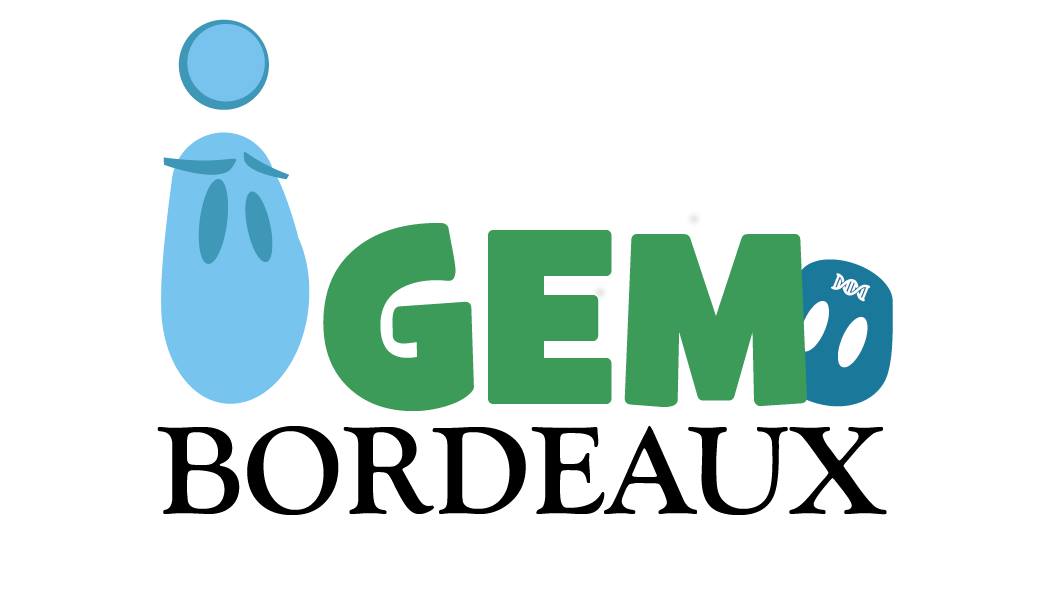(→Data recovery Bordeaux 2016) |
(→Data recovery Bordeaux 2016) |
||
| Line 71: | Line 71: | ||
[[File:T--Aix-Marseille--Dynamic_of_plasmid_curves.jpg|800px|800px|center|thumb| Dynamics of surface and liquid matings for the plasmids R1 and Rldrdl9 for different initial densities. Transconjugant production (cells per ml medium at stationary phase) in (a) liquid cultures and (b) surface cultures is shown. The plotted points for the liquid cultures represent means; those for the surface cultures represent means 2 x SE. Squares, Matings with Rldrdl9; Triangles, matings with R1.]] | [[File:T--Aix-Marseille--Dynamic_of_plasmid_curves.jpg|800px|800px|center|thumb| Dynamics of surface and liquid matings for the plasmids R1 and Rldrdl9 for different initial densities. Transconjugant production (cells per ml medium at stationary phase) in (a) liquid cultures and (b) surface cultures is shown. The plotted points for the liquid cultures represent means; those for the surface cultures represent means 2 x SE. Squares, Matings with Rldrdl9; Triangles, matings with R1.]] | ||
| + | Their conclusion on the plasmid transfer rate are: | ||
| + | |||
| + | On SSS, when colony density is high, many colonies meet, resulting in the original donors being responsible for most transconjugant production. At low colony densities, few colonies meet, and transitorily derepressed transconjugants are the primary donors. This hypothesis is supported by the observation that transconjugant yields for Rldrdl9 and R1 were similar at the lowest colony density, suggesting that in both cases the primary donors were derepressed. | ||
| + | On liquid batch cultures, transitory derepression does not play a significant role, since during the growth period the derepressed transconjugants are a very small fraction of the randomly distributed donor populations (Levin et al., 1979). | ||
<references/> | <references/> | ||
Collaborations
Our collaborations
Modeling for Toulouse 2016
We conceived a model of plasmid loss for the Toulouse team.
Data recovery Bordeaux 2016
In order to help the iGEM team Bordeaux, we had to read the paper « Dynamics of plasmid transfer on surfaces » [1] and collect and organize some data about their experiments on plasmids transfer. Thanks to this, the iGEM team Bordeaux can compare those results to their own computaionnal results.
Here is a summary of this article:
Using a surface slide system (SSS) the dynamics of the plasmid R1 and its permanently derepressed mutant Rldvdl9 in surface cultures of Escherichia coli K12 was examined. The experiments were carried on E.coli K12 strain J53 hosting the plasmid R1 or it's premanently repressed mutant R1drd19. those two strains were used as donor cells. The recipient used is E.coli CH50.
Here is a summary of their result on the effect of initial cell density on bacterial growth and plasmid transfer in surface and liquide culture.
| Surface mating JS3(RI) x CSHSO | Surface mating J53(Rldrd19) x CSHSO | ||||||||
| Initial | Recipient | Donor | Transconjugant | Total | Initial | Recipient | Donor | Transconjugant | Total |
| 10^7 | 3,8*10^8 | 1,5*10^8 | 2,1*10^5 | 5,2*10^8 | 10^7 | 6,6*10^7 | 1,7*10^8 | 9,4*10^7 | 3,3*10^8 |
| 10^6 | 3,1*10^8 | 1,8*10^8 | 2,1*10^5 | 4,8*10^8 | 10^6 | 1,4*10^8 | 2,5*10^8 | 4,4*10^7 | 4,4*10^8 |
| 10^5 | 2,2*10^8 | 1,8*10^8 | 6,5*10^4 | 4,1*10^8 | 10^5 | 1,4*10^8 | 1,9*10^8 | 8,0*10^6 | 3,4*10^8 |
| 10^4 | 2,7*10^8 | 1,9*10^8 | 3,0*10^4 | 4,6*10^8 | 10^4 | 1,6*10^8 | 2,3*10^8 | 1,8*10^6 | 3,9*10^8 |
| 10^3 | 2,7*10^8 | 1,9*10^8 | 3,0*10^4 | 4,6*10^8 | 10^3 | 2,3*10^8 | 2,6*10^8 | 4,7*10^5 | 4,9*10^8 |
| 10^2 | 2,9*10^8 | 2,2*10^8 | 1,6*10^4 | 5,0*10^8 | 10^2 | 2,4*10^8 | 2,2*10^8 | 4,1*10^4 | 4,7*10^8 |
| Liquid mating JS3(RI) x CSHSO | Liquid mating JS3(Rldrd19) x CSHSO | ||||||||
| Initial | Recipient | Donor | Transconjugant | Total | Initial | Recipient | Donor | Transconjugant | Total |
| 10^7 | 2,2*10^8 | 9,8*10^7 | 4,4*10^3 | 3,1*10^8 | 10^7 | 1,2*10^8 | 6,8*10^7 | 7,4*10^7 | 2,6*10^8 |
| 10^6 | 1,7*10^8 | 8,5*10^7 | 5,9*10^3 | 2,6*10^8 | 10^6 | 1,7*10^8 | 3,7*10^7 | 8,4*10^7 | 2,9*10^8 |
| 10^5 | 2,0*10^8 | 6,9*10^7 | 7,9*10^3 | 2,7*10^8 | 10^5 | 1,7*10^8 | 2,7*10^7 | 7,4*10^7 | 2,7*10^8 |
| 10^4 | 2,7*10^8 | 6,1*10^7 | 1,6*10^4 | 2,7*10^8 | 10^4 | 1,9*10^8 | 1,8*10^7 | 6,6*10^7 | 2,7*10^8 |
| 10^3 | 2,9*10^8 | 4,9*10^7 | 1,9*10^4 | 2,9*10^8 | 10^3 | 2,3*10^8 | 7,4*10^6 | 4,7*10^7 | 2,8*10^8 |
| 10^2 | 4,1*10^8 | 1,0*10^7 | 6,0*10^3 | 4,1*10^8 | 10^2 | 2,6*10^8 | 3,7*10^6 | 1,2*10^7 | 2,8*10^8 |
They have made the following curves to show their results.

Their conclusion on the plasmid transfer rate are:
On SSS, when colony density is high, many colonies meet, resulting in the original donors being responsible for most transconjugant production. At low colony densities, few colonies meet, and transitorily derepressed transconjugants are the primary donors. This hypothesis is supported by the observation that transconjugant yields for Rldrdl9 and R1 were similar at the lowest colony density, suggesting that in both cases the primary donors were derepressed. On liquid batch cultures, transitory derepression does not play a significant role, since during the growth period the derepressed transconjugants are a very small fraction of the randomly distributed donor populations (Levin et al., 1979).
- ↑ [http://www.microbiologyresearch.org/docserver/fulltext/micro/136/6/mic-136-6-1001.pdf?expires=1476877711&id=id&accname=guest&checksum=2F0A0D5E398EA4193E7D9B5926D0CCE5 Lone Simonse Department of Zoology, University of Massachusetts, Amherst, MA 01003, USA .]
Colaboration made by Pretoria 2016
The iGEM team Pretoria 2016 hepled us focusing on the socio-economic and political issues facing the current platinum sector, including the Marikana strikes.
You can find their work here.



